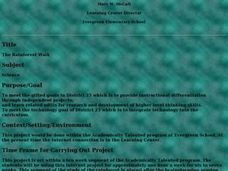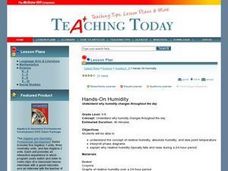Curated OER
Sunny Delight
First graders explore completing experiments through the scientific method.
Curated OER
The Sky Jeopardy
First graders reinforce concepts about sun, moon, day, night and sky by playing the Sky Jeopardy game. In the end, 1st graders get to nibble crackers in order to show the different phases of the moon.
Curated OER
Microbes and Our Food
Young scholars investigate foodborne illnesses and involved microbes. They identify major pathogens and then research and explain how they contaminate foods and how people are affected.
Curated OER
The Solar System
Students research origin of solar system, discuss theories they have found, and create paper mache solar system models.
Curated OER
The Rainforest Walk
Fourth graders research the characteristics and inhabitants of the rainforest. They demonstrate their ability to communicate using e-mail and create a class presentation of their research.
Curated OER
Design Your Own Rube Goldberg Machine
Students participate in a culminating activity for a unit on Energy and Simple Machines. They are challenged to incorporate simple machines in to a complex mechanical system. While designing and testing their machine they will also...
Curated OER
To Float or Not to Float, That is the Question?
Ninth graders develop operational definition of density, do computations using density equation, categorize pieces of matter as being able to float on
water or not, based on density, explain why some objects sink or float based on...
Curated OER
Introduction To Digital Camera
Students identify the uses of common computer peripheral devices (printer, digital camera, scanner, LCD display). They incorporate technology into a research project or unit investigation. They work on sizing pictures and putting all...
Curated OER
Population Pyramid
Students learn about demographic population pyramids. They then design and fictitious nation and draw its population pyramid.
Curated OER
Winogradsky Column Unit
Students are introduced to two changes, physical and chemicl, in order to prepare them to comprehend what changes take place in a Winogradsky Column. They participate in two activities including completion of a worksheet, balloon...
Curated OER
Hinges I, Hinges II
Students use their bodies in daily activities, by promoting a regular routine of using large and small motor skills, personal space, and boundary awareness. They move a scarf to the rhythm of the different kinds of music the teacher...
Curated OER
Vertebrates
Learners identify and describe five main groups of the Phylum Chordata. They discover that the Phylum Chordata is the vertebrates. Students identify the main difference between invertebrates and vertebrates. They read passages about...
Curated OER
Who is the Real Roman?
Students describe what everyday life was like in ancient Rome and identify the various classes of people living in ancient Rome. They participate in a game called "The Real Roman," role-playing and trying to convince the class they are...
Curated OER
Modeling the Change of Seasons
Students evaluate data to determine changes in length of day. They model the revolution of Earth around the sun to show changes in length of day and sun angle and illustrate how the sun angle affects the change of season.
Curated OER
Hands-On Humidity
Young scholars examine why humidity changes throughout the day. They study the concept of relative humidity, absolute humidity, and dew point temperature. They interpret phase diagrams and explain why relative humidity typically falls...
Curated OER
Exploring the Nervous System Through Disease and Injury
Students are introduced to the nervous system. In groups, they research the relationship between disease and injury and how it affects the nervous system. To end the lesson plan, they present their findings to the class and create a...
Curated OER
Pythagoreum Theorem
Middle schoolers practice assessing how to apply the formulas for the area of parallelograms and triangles. They recount the contributions of Pythagoras and apply the theories of the Pythagorean theorem in a group project to calculate...
Curated OER
Wilson Stands Alone in His Plan for World Peace
Students study the Fourteen Points. They examine motives behind Wilson's Fourteen Points and why most of them were rejected by France. They answers questions concerning primary resources (casualty list and before and after...
Curated OER
Satire in Fiction
Twelfth graders identify satire in various fictional texts. In this language arts lesson, 12th graders will learn to define satire, parody, and caricature. Students will identify different forms of satire in historical and...
Curated OER
Aesop's Fables (Grade 3)
Third graders develop a presentation based on Aesop's Fables. In this Aesop Fables and presentation instructional activity, 3rd graders examine the characteristics of fables and how to interpret them. They choose one of Aesop's Fables to...
Curated OER
Middle Ages Timeline
Students research a historical figure from the Middle Ages. For this Middle Ages lesson, students present important events of their characters life and of the time. Students write a time card for each significant event. ...
Curated OER
Alexander Calder: Master of Balance
Students build simple mobiles. In this equilibrium lesson, students investigate the functions of three types of levers as they analyze artwork by Alexander Calder. Students then create their own simplified mobiles.
Curated OER
Mira, Mira on the Wall: Reflections
Students investigate and perform reflections and symmetry. In this geometry lesson, students compare and contrast the relationship between reflections and symmetries.
Curated OER
Exploring the Exponential Function
Learners collect and analyze data regarding exponential functions of the form y = abx. Students explore the affects of changing parameters on the graph of the function.























